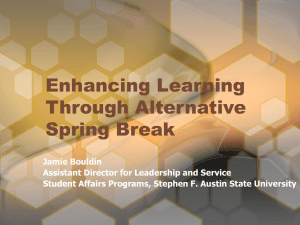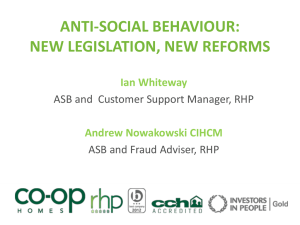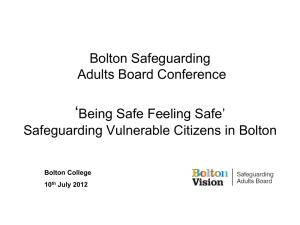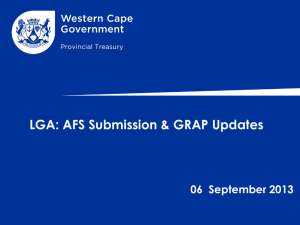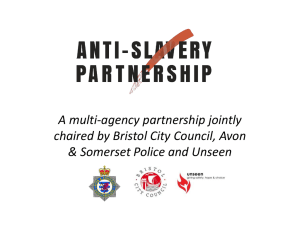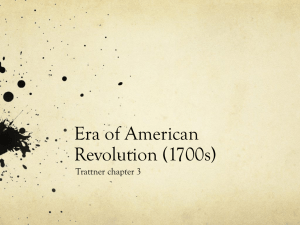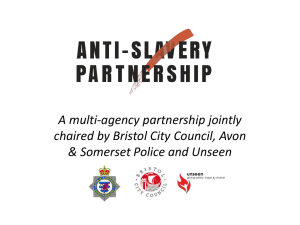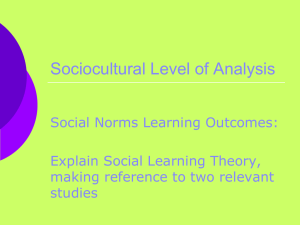All Wales ASB Group - Chartered Institute of Environmental Health
advertisement
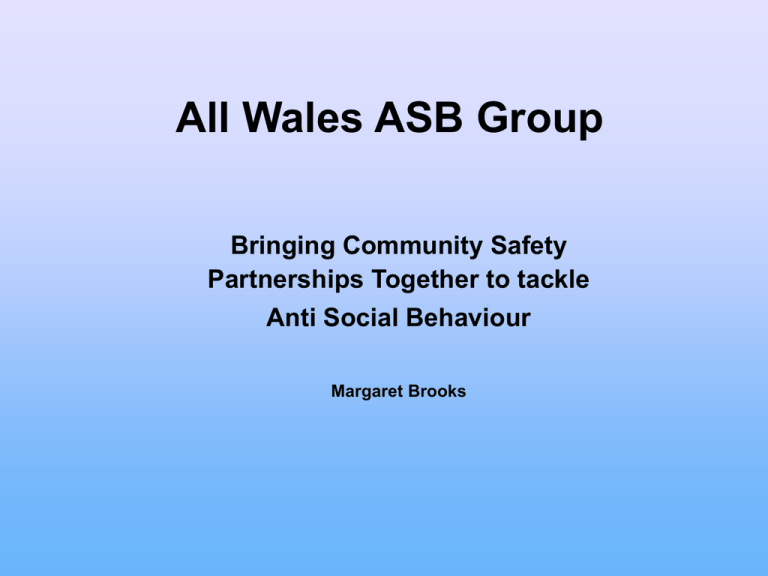
All Wales ASB Group Bringing Community Safety Partnerships Together to tackle Anti Social Behaviour Margaret Brooks ASB • ASB is “behaviour that causes or is likely to cause harassment, alarm or distress to one or more people who are not in the same household as the perpetrator” • A wide definition is used allowing the focus to be on individuals, the victims and perpetrators, • It has a wide impact: personally, economically and on social cohesion and development, • Perpetrators can be any age, it is not just a matter of ‘rowdy’ teenagers, • The level of ASB reflects the health of a community and how the reputation of the CSP is regarded. Partnership working and statutory obligation to tackle asb • Partnership working – sharing resources • Your organisation is already part of the solution to tackling asb through the Community Safety Partnership which include: Police, Environmental Health Departments, Youth Offending Team, Housing, Fire and Rescue Services, Social Services, Probation, Voluntary and Community organisations • Community Safety Partnerships (CSPs) established following the publication of the Crime and Disorder Act in 1998 (reviewed in 2006). Section 17 requires local authorities and police to do all that they can ‘reasonably can to prevent crime and disorder’ in their Area. • Statutory guidance issued by Assembly Government in 2005 for the purposes of s.218A of the Housing Act 1996. • This act placed a duty on social landlords to prepare an asb policy and procedures for dealing with asb. Sharing Information Section 115 of the Crime and Disorder Act 1998 provides authorities with a duty to exchange this information. The information will be disclosed by way of justified interference in accordance with the prevention of crime and disorder as outlined by Article 8 (2) of the European Convention. Minimum Standard for tackling asb • • • • • • • • Working towards prevention of ASB Not punitive process ASBO/ enforcement tools should be last resort Education/ awareness raising/ reassurance/Diversionary Best practice Aim to improve services dealing with asb Empower and engage residents to work with you to tackle asb Support for victims and witnesses Partnership response STAGE 1: First Warning letter issued (if verbal warning given, this must be followed up with a letter) STAGE 2: Second referral to ASB Reduction Coordinator following complaint/incident of ASB within 6 months Second warning letter issued and if necessary appropriate officer from Partnership agency to visit individual to highlight concerns about their involvement with ASB STAGE 3: Third referral to ASB Reduction Coordinator; case discussed at case conference Partnership response Case conference Acceptable Behaviour Contract (ABC) or Parenting Contract agreed and signed by both parties, restorative justice, YISP/Prevention Referral Monitoring (ASB Reduction Coordinator to coordinate process) Breaches of contract to be reported to ASB Reduction Coordinator Meeting to discuss next steps and enforcement Extend ABC Ongoing discussion at Problem Solving Group Successful completion – no further reports Positive feedback letter Obtain crASBO/ ASBO N.B. relevant parties must certify that all in agreement for application Demotion of tenancy, premise closure, eviction, injunctions Problem Solving Groups • Purpose - to bring together appropriate agencies to coordinate responses to incidents of ASB in Pembrokeshire • Responsibilities: – Monitor overall progress of cases, making decisions regarding ABCs, Parenting Contracts and ASBOs where necessary – Act as source of information/advice on ASB cases – Consider performance information from Police and other relevant partner agencies in order to identify ASB patterns and trends – Make recommendations regarding environmental responses to ASB issues (street lighting, CCTV, layout of street furniture) – Periodically review ASB processes/procedures in order to ensure that best practice is adhered to Case Conferences • Purpose – to discuss individual case of ASB • Convened at discretion of Problem Solving Group or ASB Reduction Coordinator • Relevant partner agency representatives should attend • Parents/carers may be invited where appropriate • Appropriate agencies will be identified to take ownership for progress of case – coordinated by ASB Reduction Coordinator • Actions/details from meeting reported back to ASB team Hotspots • Referring agencies provide evidence - held centrally in case files with ASB team • Used to produce hotspot lists – locations / victims / offenders • Need to collate cross-agency information • Produce lists of repeat or vulnerable victims and offenders Victim focus • No national guidance, matrix being developed to score history, vulnerability and support • Currently working on force-wide definition/criteria for repeat / vulnerable victims Each CSP introduces a process for the identification of repeat and vulnerable victims (by means of the agreed Vulnerability Risk Assessment) and management of respective action plans. • Training for call centre staff • When call received, visits to repeat victims and offenders by YOT/ NPT/ Bobby Van etc. where appropriate • Minimum standards Minimum standards Key points: – Multi agency solutions – Proportionate responses – Support for victims – Community involvement – Transparency – Effective Coordination and tasking of ASB incidents • • • • • • • • • • • • • • • • • • • • • • • • • • • • • • • • We are already meeting the standards – A wide range of activities Community Safety Partnership agreement Antisocial Behaviour landlords policy Statement of procedures ASB Departmental referrals Other agency referrals ASB toolkit Standard letters Tenancy agreements Tenants Handbook Allocation policy Police Strategy Local Action Plan (PH) Tenant participation strategy Antisocial behaviour policy Equal opportunities policy Youth intervention policy Tenants newsletters Problem solving groups ASB forums – social landlords Tenant Panel Focus groups Tenant forum Housing services forum Area based meetings (CSP/NPT) YOT, TAC, NP, TIC, SS, Over 15’s services, project Pearl Tenancy support officers Visioning days, Tidy Town Not in my Neighbourhood Week SPLASH Bobby van Websites for finding out more about ASB (PCC and Home Office launch today) Informing tenants, homeowners, businesses and the public • Giving people an opportunity to feel a sense of community with shared values • ASB and disrespect for people and local environment are not tolerated. • Majority of people are not fearful of using public space and are free to enjoy their homes without disturbance and or harassment by the minority • People are confident they have full support of agencies in challenging unacceptable behaviour • People are kept informed of action taken to tackle asb and are encouraged to play an active part in their communities. Cost to your organisation • Changes coming to all organisations with cut backs of staff, training and capital. • Changes in legislation • Changes to legal and court –less availability, less legal support • Changes in policing, cutbacks and restructuring • Sharing costs by sharing resources and information • Getting the most out of your partners ie supporting evidence, statements • Introduction of Police Commissioners April 2012
